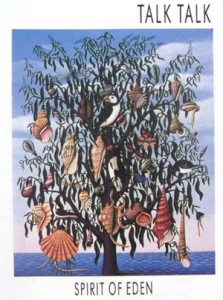One of my favorite albums of the 1980s is Talk Talk’s Spirit of Eden.
This powerful, strange, and beautiful album (which has been called “the missing link between Miles Davis and Radiohead”) almost single-handedly launched the post-rock genre and continues to influence many of the world’s top musicians.
Whether or not you like the music, however, I hope you’ll be inspired by the story of its creation.
The Creative Journey
Talk Talk rose to prominence in the early ’80s with synth-pop hits such as “It’s My Life.” After three popular albums, however, they abandoned the style that brought them fame and (much to their record company’s chagrin) tried something different.
Very different.
The Creative Cocoon
From 1987-1988, the band recorded in a sort of “creative cocoon”—forbidding record executives and even their manager from attending their recording sessions or listening to any of the tapes until the entire project was complete.
The music (which they performed largely by candlelight or completely in the dark) was mostly improvised and pieced together through digital editing (in the early days of that technology), allowing the musicians to play spontaneously and explore new territory. They supplemented their standard rock instruments with an eclectic ensemble that included trumpet, violin, oboe, cor anglais, and shozygs (experimental instruments, played by their inventor, Hugh Davies).
What emerged was a new form of music that incorporated elements of pop/rock, avant-garde classical, free-form jazz, ambient music, and a style that didn’t even have a name yet—taking the listener on a journey from somber ruminations to powerful outbursts and, ultimately, a sense of peace and redemption truly worthy of the album’s title.
THE TAKE-AWAY
To create something truly original, it’s sometimes necessary to enter a creative cocoon—a space free from external agendas, interference, or judgment. A safe space where you’re free to explore, play, and create without fear of criticism or ridicule. A space that embodies the “spirit of Eden”—looking at the world with fresh eyes, unclouded by the knowledge of what’s “good” or “bad.”
We’re ALL Creators
You don’t have to be a literal artist (painter, dancer, composer, etc.) to benefit from a creative cocoon. Whether you’re a musician, a writer, a business-person, or a stay-at-home parent, you are an artist—creating your own life, day by day, moment by moment.
Whether you’re recording an album, creating a new piece of software, writing a business proposal, or just trying to figure out what you want to do with your life, it can be tremendously beneficial to take time away from the noise of the world and other people’s agendas.
For me, as a writer, this “cocoon” means giving myself time and space to write before I show it to anyone. It also means that when I am ready to share it, I start with supportive people—people whose feedback is always given with the intent of nurturing and encouraging me rather than passing judgment.
Also, remember that the judges and naysayers aren’t always external. So when the inner critic rears its head during your creation process, simply tell it: “Not now.”
A Time to Leave the Cocoon and Fly!
This doesn’t mean, however, that there’s not a time and place for editors, critics, and even record executives. At a certain point, it is beneficial to spell-check your novel, think about more effective ways to convey your message, and market what you’ve created.
Just make sure that you take the steps in the proper order: first you go into the creative cocoon, then you emerge and fly out into the world!
If you skip the cocoon stage, or if you leave a cocoon prematurely, you might be discouraged by critics, naysayers, or even well intentioned people who simply don’t share your vision. But once your creation has matured in a supportive environment, it (and you) will be strong enough to withstand almost any resistance.
For instance, when Talk Talk first shared the completed Spirit of Eden tapes with record executives, the company pressured them to make changes and eventually sued them (unsuccessfully) for making “commercially unsatisfactory” music. Yet, because the band had allowed their vision to grow to fruition in a nurturing cocoon, they were able to resist the pressure and release the album they wanted to—an album that revolutionized modern music and has delighted and inspired listeners for the last quarter century!
What might come out of YOUR cocoon?
Talk Talk gave themselves the gift of a one-year creative cocoon and created a beautiful new form of music. If you gave yourself a creative cocoon, what could you create?
You don’t have to take a whole year. You could give yourself a few days, an afternoon, or even an hour a week when you shut out the external world, get in touch with your creativity, and give yourself permission to play!
I hope you’ll give yourself this gift—and I can’t wait to see what emerges!
…
Have you ever gone into a “creative cocoon”? If so, what emerged? If not, is this something you’d like to try? How might you incorporate this into your life? I’d love to hear your thoughts and experiences!

